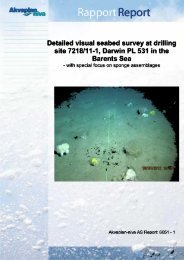A study of the priority substances of the Water Framework Directive ...
A study of the priority substances of the Water Framework Directive ...
A study of the priority substances of the Water Framework Directive ...
You also want an ePaper? Increase the reach of your titles
YUMPU automatically turns print PDFs into web optimized ePapers that Google loves.
..:::::::::: dichloroethane (EDC)<br />
..:::30<br />
10 Dichloroethane (EDC)<br />
� EDC is used as solvent and as raw material in<br />
PVC production.<br />
� In o<strong>the</strong>r countries, EDC has been found in<br />
groundwater in areas with PVC industry.<br />
� There are no data on environmental distribution<br />
<strong>of</strong> EDC outside Grenland in Norway.<br />
� Fur<strong>the</strong>r screening may be necessary in<br />
Grenland.<br />
Production and use<br />
Dichloroethane is being used in syn<strong>the</strong>sis <strong>of</strong><br />
VCM for in PVC production. There is one such<br />
plant in Norway, at Rafnes in Grenland.<br />
Dichloroethane is also widely used as industrial<br />
solvent and glue.<br />
Emissions, discharges,<br />
distribution and hot-spots<br />
Only Rafnes sees large scale EDC use in <strong>the</strong><br />
period. From 1977 to 1985 unintentional<br />
ground pollution. Most spills, contaminated soil<br />
and contaminated ground water have been<br />
cleared. The volumes are not known. Typically<br />
<strong>the</strong> EDC-concentrations in <strong>the</strong> groundwater<br />
have dropped from around 1000 mg/l in <strong>the</strong><br />
mid 80'ies to less than 50 mg/l today. Remedial<br />
action (pumping and stripping <strong>of</strong> groundwater)<br />
have prevented dispersion <strong>of</strong> <strong>the</strong> contaminated<br />
ground water.<br />
The emissions to air were reported by Norsk<br />
Hydro to be 60 tons in 1996, and 35 tons in<br />
1995 and 10 tons/year from 1997 to 2002,<br />
dropping to 4 tonnes from 2003. The figures<br />
include both fugitive/diffuse emissions, point<br />
sources and accidental releases. Discharges to<br />
water in 2003 were 3 kilos.<br />
Dichloroethane may form in uncontrolled incineration<br />
processes (such as landfill fires). No data<br />
are available on amounts, but <strong>the</strong>y are considered<br />
by SFT to be small. There are 5-10 large<br />
landfill fires in Norway annually.<br />
Marine<br />
There are no available data on dichloroethane<br />
in sea, marine sediments or marine biota in<br />
Norway.<br />
A <strong>study</strong> <strong>of</strong> <strong>the</strong> <strong>priority</strong> <strong>substances</strong> <strong>of</strong> <strong>the</strong> <strong>Water</strong> <strong>Framework</strong> <strong>Directive</strong><br />
TA-2140/2005<br />
FACTS<br />
Cas no.: 107-06-2<br />
Synonyms: EDC, etylendiklorid, ethan dichloride,<br />
acetylene dichloride, ethane, 1,2-dichloro, 2dichlorethan;<br />
chlorethylen; dichlorethan, 1,2-; dikloretan,<br />
1,2-; EDC; ethan, 1,2-dichlor- ; ethane, 1,2dichloro-<br />
; Ethylendichlorid ; Ethylenum chloratum ;<br />
Freon 150<br />
Properties: Clear colourless oily liquid. May darken.<br />
Sweet odour.<br />
Toxic effects: Slightly toxic, acute LD50 rat oral 670-<br />
890 mg/kg. A burden <strong>of</strong> 0,5-1,0 g/kg may cause<br />
death in humans. Defattening and irritant for eyes,<br />
skin and respiratory system. Possible carcinogen in<br />
humans. LC50 Daphnia magna 218 mg/l 48 hour<br />
(ClassLab and HSDB).<br />
Log Kow: 1,48<br />
Persistence: Biodegradation in soil or water is not<br />
expected to be an important environmental fate<br />
process. Half-life 4 to 9 days in lakes (volatilisation)<br />
(HSDB)<br />
DT50 water (hydrolysis) = 23 - 300 years at 15°C<br />
DT50 air = 12-121 days (ind. photolysis) CIRCA<br />
<strong>Water</strong> solubility: 8690 mg/l<br />
Molecular formula: C 2 H 4 Cl 2<br />
Metabolites: Glycolic acid, oxalic acid, chlorethanol,<br />
chloraceticacid.<br />
Fresh water, soil and groundwater<br />
The extent <strong>of</strong> <strong>the</strong> ground pollution at Rafnes is<br />
unknown.<br />
Hot-spots<br />
Rafnes in Grenland is a hot-spot, extent is<br />
unknown.<br />
Monitoring<br />
Norsk Hydro is monitoring dichloroethane<br />
emissions to air. Discharges to water or soil are<br />
unintentional and thus not monitored.<br />
Need for fur<strong>the</strong>r screening and monitoring<br />
Dichloroethane is easily degraded in fresh water<br />
and sea. Anaerobic degradation (groundwater,<br />
sediments) is slow. Documentation on levels in<br />
ground water is lacking, thus, it may be neces-

















